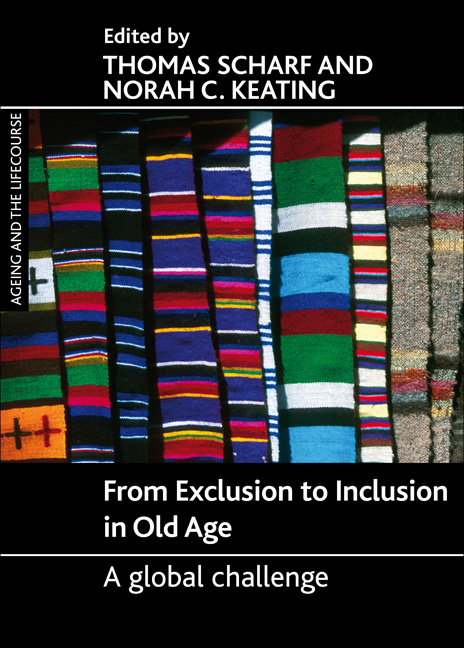Book contents
- Frontmatter
- Dedication
- Contents
- List of tables and figures
- Acknowledgements
- Notes on contributors
- Foreword
- one Social exclusion in later life: a global challenge
- two Globalisation, economic recession and social exclusion: policy challenges and responses
- three International migration: patterns and implications for exclusion in old age
- four Social inclusion of older people in developing countries: relations and resources
- five Exclusion from material resources: poverty and deprivation among older people in Europe
- six Social inclusion of elders in families
- seven The impact of changing value systems on social inclusion: an Asia-Pacific perspective
- eight Age discrimination as a source of exclusion in Europe: the need for a human rights plan for older persons
- nine Towards inclusive built environments for older adults
- ten Revisiting social exclusion of older adults
- Index
six - Social inclusion of elders in families
Published online by Cambridge University Press: 07 September 2022
- Frontmatter
- Dedication
- Contents
- List of tables and figures
- Acknowledgements
- Notes on contributors
- Foreword
- one Social exclusion in later life: a global challenge
- two Globalisation, economic recession and social exclusion: policy challenges and responses
- three International migration: patterns and implications for exclusion in old age
- four Social inclusion of older people in developing countries: relations and resources
- five Exclusion from material resources: poverty and deprivation among older people in Europe
- six Social inclusion of elders in families
- seven The impact of changing value systems on social inclusion: an Asia-Pacific perspective
- eight Age discrimination as a source of exclusion in Europe: the need for a human rights plan for older persons
- nine Towards inclusive built environments for older adults
- ten Revisiting social exclusion of older adults
- Index
Summary
Introduction
Social interaction, understood as the engagement in meaningful relations with others, is an important element when considering the concept of social exclusion (Burchardt et al, 2002). The absence or poor quality of contact with significant others – family, friends, work colleagues and community groups – is widely acknowledged as being a key indicator of social exclusion (Hills et al, 2002). Although social interaction takes place in many different settings, family relationships provide one of the main contexts within which people act towards or respond to others (Allan, 1999). Families, therefore, fulfil many tasks that mitigate the risk of social exclusion. They are purveyors of social support, assuring that the most vulnerable members receive help. They are the medium through which individuals remain integrated into wider systems of support, and they can provide help, advice and access to external resources such as health and social care. Families can be a source of sustained and enduring support, where other forms of social interaction may be less durable. Family relationships, therefore, form a key component of the dimensions of participation and integration that are central to social inclusion (Scharf et al, 2001).
If the positive value of family relations in promoting social inclusion is not in doubt, it is less clear whether the features of contemporary societies are propitious in providing the conditions within which families can flourish. From a demographic perspective, population ageing and falling fertility rates are changing family structures to the extent that family roles are less clear than in the past. Combining work and family life is increasingly complex. The fragility of welfare and social security systems places new pressures on family members, and these pressures can be manifest in decisions that are made concerning the transfer of resources within families. Family norms relating to obligations and responsibilities between the generations may also be changing. Globalisation and its consequences for national and local economies also contribute to the emergence of new family forms (Izuhara, 2010). These social trends can, under certain circumstances, increase the risk of individuals becoming excluded from the positive contribution that families can make to enhancing quality of life.
Although social exclusion can be encountered at any stage in the life course, individuals in later life are confronted with specific circumstances, which in turn pose particular challenges.
- Type
- Chapter
- Information
- From Exclusion to Inclusion in Old AgeA Global Challenge, pp. 89 - 108Publisher: Bristol University PressPrint publication year: 2012
- 2
- Cited by

